It’s no wonder that we abuse Nokia cell phones more often than others. The gadgets produced by the Finnish manufacturer are always in demand.
Today, we are going to stress test the Nokia C5, a Symbian S60 3rd edition based smartphone that was put on sale in 2010 for those people who run a tight budget. The cell phone comes in a compact retail package (Pic. 1) and it is boxed with all necessary accessories – stereo headset, wall charger, microUSB cable and user guide (Pic. 2).
The Nokia C5’s classic design includes big keys, aluminium back cover and stainless steel casing (Pic. 3, 4). The phone is powered by 1050 mAh Lithium Ion battery. The display viewing angles are very poor.
Results

Pic. 1. Box
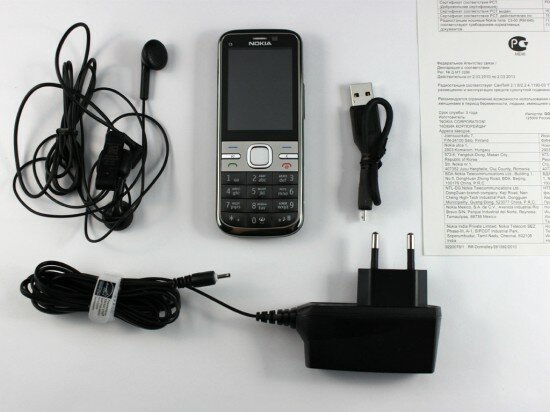
Pic. 2. Accessories
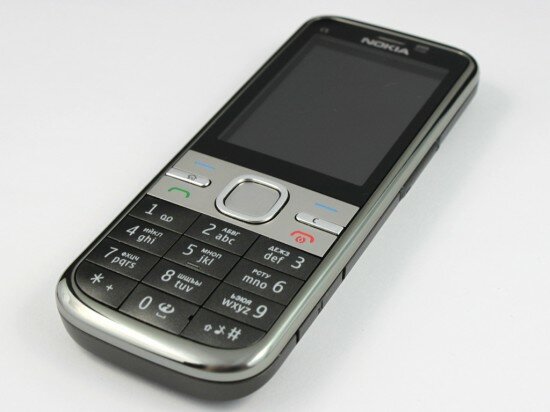
Pic. 3. Nokia C5 (front panel)
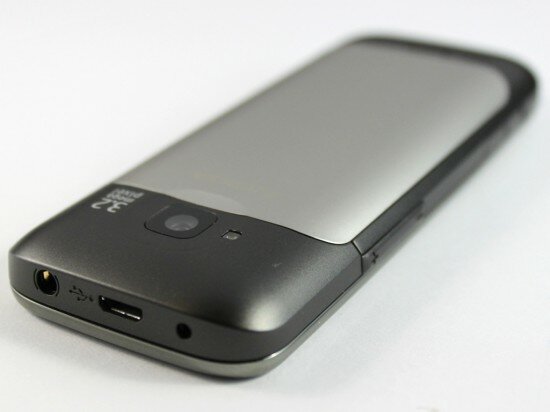
Pic. 4. Nokia C5 (back panel)
1. Nokia C5 stress test. Stage 1 — Light shocks
1.1 Drop test
The first test that we prepared for the Nokia C5 was the drop. During the test, we successively dropped the Nokia C5 with each face, edge, and corner on the ceramic tile (video 2) from 30 cm (11.8 inches) and on the carpet (video 1) from 1 m (3.28 ft).
The phone showed no damage after the drops on the tile. However, the result of the drop on the carpet from 1 m (3.28 ft) was much worse: the back cover opened after each fall and became a bit deformed at the end of the test. The SIM Card was dislodged after we dropped the phone onto its top edge. In the result of the bumps, a small gap appeared between the back cover and the casing (Pic. 5).
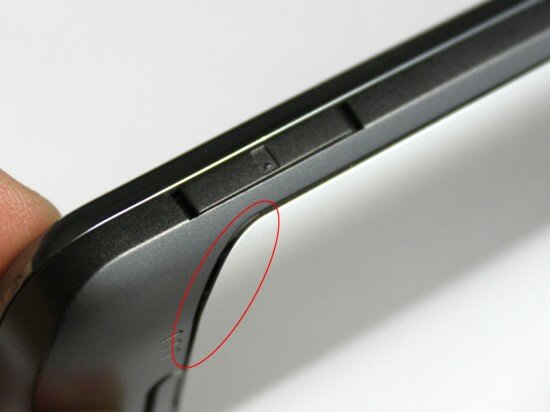
Pic. 5. The gap between the casing and the back cover
Video 1. Drop on the carpet from 1 m (3.2 ft)
The grade is 20 (with 30 being the highest possible grade)
Video 2. Drop on the tile from 30 cm (11.8 inches)
The grade is 30 (with 30 being the highest possible grade)
1.2 Squeeze test
In this test, we found out how the Nokia C5 withstands squeezing. We placed the phone on a table and applied a 3 kg (6.6 lbs) pressure from a wooden bar above it (Pic. 6). However, it was too little weight to cause any damage. The gadget stayed absolutely safe, partly due to the casing that is flat and has no raised parts.
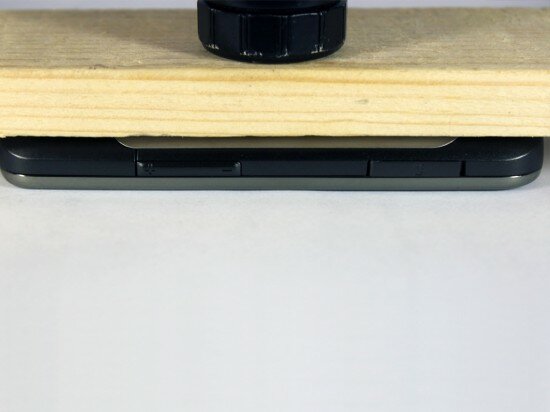
Pic. 6. The Nokia C5 under the wooden bar
The grade is 24 (with 24 being the highest possible grade)
1.3 Bend test
Portable electronic gadgets sustain a lot of physical shocks in everyday use. Bending is one of the most frequent threats for cell phones.
In order to find out how the Nokia C5 stands up to bends we put it onto the two planks so that each edge of the phone lies on a single plank. Then we hitched a string with 1 kg load (2.2 lbs) on top of the device. The handset sustained no sign of bend and stayed functional.
The grade is 24 (with 24 being the highest possible grade)
1.4 Durability
In this test, we placed the Nokia C5 inside a drum together with keys, pennies, and plastic balls to simulate what might be happening in a man’s pants pockets while carrying the phone. The drum viciously rotated the gadget for 5 min. in order to make it look as old as possible.
After the test, we examined the device. Despite the scuffs, the front panel looked attractive (Pic. 7). The steel edging sustained damage only on the corners of the phone. The plastic parts of the back panel proved to be fragile (Pic. 8). But the back cover showed no damage at all. We saw some scuffs and cracks on the screen, but they did not ruin the quality of the picture and were visible only under bright lights (Pic. 9).
Video 3. Drum rotation
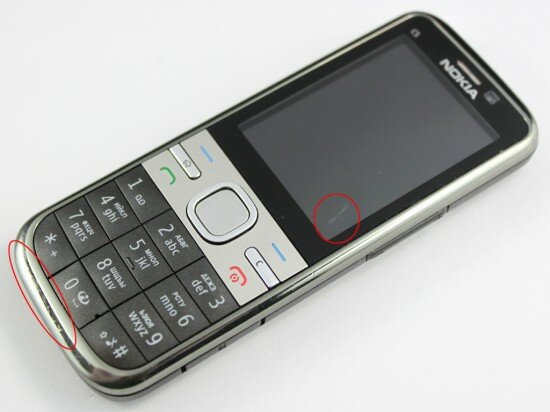
Pic. 7. Scuffs on the front panel
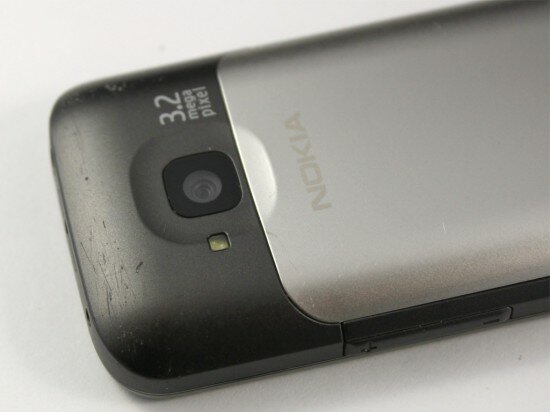
Pic. 8. The back panel
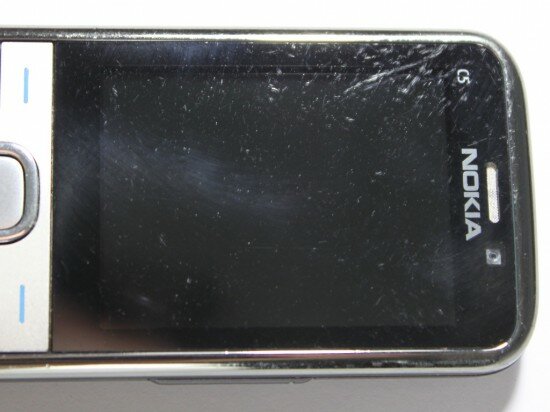
Pic. 9. Scuffs on the screen
The grade is 15 (with 15 being the highest possible grade)
1.5 Scratch test
In order to test the material of which the Nokia C5 is made, the phone was subjected to a nail fixed in the machine. The force of scratches was 100 g (0.22 lbs). The machine made a small scratch on the screen (video 4). The back panel sustained no visible scratch.
Video 4. Screen scratching
The screen gets 10 points (with 15 being the highest possible grade)
The back panel gets 15 points (with 15 being the highest possible grade)
1.6 High temperature
Heat poses a great threat to all cell phones. Display brightness and color quality may be diminished if a phone is exposed to high temperatures. Sun rays, for example, may melt the glue that sticks the screen glass and the front panel together.
In this test, we placed the Nokia C5 in a metallic container 5 cm from the electric bulb (40 Wt). The bulb heated the phone for 3 min. (video 5). The gadget survived such test and performed perfectly afterwards.
Video 5. High temperature test
The grade is 12 (with 12 being the highest possible grade)
1.7 Dust test
Durability of any cell phone (that’s how we call the period of time from buying a phone to its first break) may be tested by placing gadgets in dirty environments for some time (e.g., carrying cell phones in pants pockets). Those people who use their handsets for a year or two can probably find dust in hard-to-reach parts of their phones: in loudspeaker grills, seams and even under a screen glass.
In order to check the Nokia C5’s dust resistance, we took an enclosed tray containing dust and threw the phone inside it. Then, we made it vibrate viciously for 2 min. After the test, we examined the gadget.
Practically, all handsets that are made of plastic and steel are not dust resistant. And the Nokia C5 is not an exception. As you can see from picture 10, a lot of dust penetrated the phone through the gap between the back cover and the casing that was caused by the bumps. By the way, the back cover wasn’t firmly attached even before the start of the stress test – the build quality leaves much to be desired.
The microSD card slot and the ear-microphone jack stayed clean (Pic. 11). Much dust and sand penetrated the keyboard. The grains of sand made it squeak each time when we pressed the keys. It took an hour to clean all the dust and sand out of the keyboard. The phone stayed absolutely functional, though.
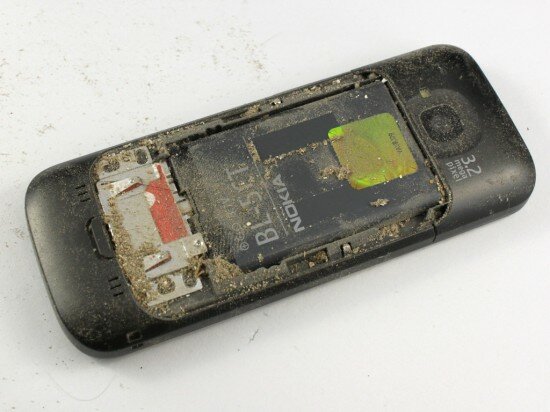
Pic. 10. Dust under the back cover
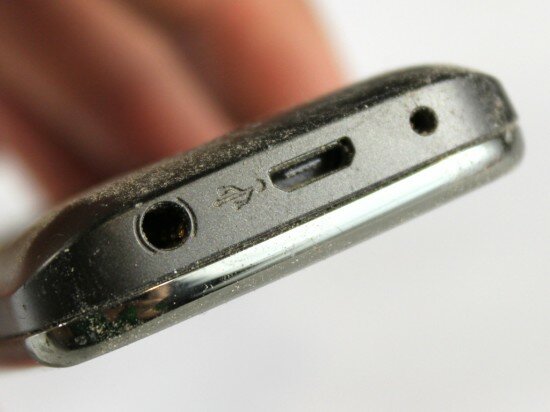
Pic. 11. Ear-microphone jack and charger jack stayed clean
The grade is 12 (with 12 being the highest possible grade)
1.8 Connectivity
Actually, this is not a stress test. This is a signal quality test. It’s very important to check the quality of the Nokia C5’s reception because this is the main function of any cell phone. In order to find out how well the C5 receives signals from cell towers, we did the following:
We placed the handset inside a box. Then we foiled the box (the foil served as a shield) and made a 40 x 45 mm (1.57 x 1.77 inches) hole in it. Then we started to make calls in order to check the signal strength of the phone (video 6). During the talk time, the reception fell only by 1 – 3 points. During the stand-by, the set of bars displayed the maximum signal strength (6 bars). Generally speaking, the Nokia C5 received all the incoming calls with no problem.
Video 6. Connectivity test
The grade is 15 (with 15 being the highest possible grade)
After the 1st stage of the stress test, the Nokia C5 got 182 (with 192 being the highest possible grade)
2. Nokia C5 stress test. Stage 2 — Tough conditions
2.1 Drop test
This time, we increased the height of the drop on the carpet (video 7) to 1.5 m (4.9 ft) and the height of the drop on the tile (video ![]() to 50 cm (1.64 ft).
to 50 cm (1.64 ft).
The result was worse than the previous time. During this test, the back cover was constantly falling off. The middle edge of the housing faceplate separated from the casing after another drop on the carpet. But it stayed safe and we put it back with no problem. The SIM Card was dislodged again.
The gap between the back cover and the casing grew larger after this test. The same can be said about the seam between the front panel and the back panel. Despite this damage, the phone stayed functional.
Video 7. Drop on the carpet from 1.5 m (4.9 ft)
The grade is 30 (with 30 being the highest possible grade)
Video 8. Drop on the tile 50 cm (1.64 ft)
The grade is 30 (with 30 being the highest possible grade)
2.2 Squeeze test
The phone showed no damage when we applied 10 kg (22 lbs) pressure above it. However, the wooden bar made the back cover bear greatly against the casing. The front panel and the back panel also bore against each other.
The grade is 24 (with 24 being the highest possible grade)
2.3 Bend test
We made the bend test tougher. The weight of the load was 5 kg (11 lbs). The handset sustained a slight bend (Pic. 12), but the circuit board showed no damage.
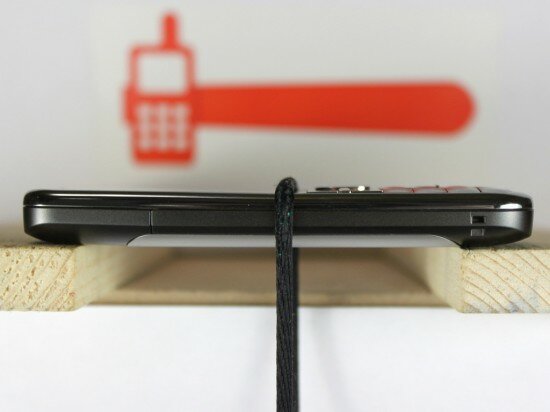
Pic. 12. Bend caused by 5 kg (11 lbs) load
The grade is 24 (with 24 being the highest possible grade)
2.4 Durability
At this stage of the test, we placed the gadget inside the drum for 10 min. As a result, the gunmetal effect edging was scuffed so much that we saw the plastic under it (Pic. 13). To compare to the result showed by the Nokia 2700 in the same test https://gadgetstress.com/2010/10/stress-test-of-the-nokia-2700, we can say that the gunmetal effect edging of the Nokia C5 is quite durable. The part of the back panel that is made of plastic sustained more damage compared to the previous durability test (Pic. 14). The back cover, however, stayed attractive. Many new cracks ruined the quality of the display (Pic. 15).
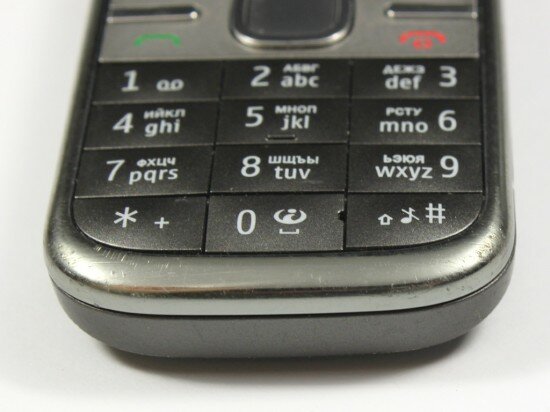
Pic. 13. Scuffs on the gunmetal effect edging

Pic. 14. The back panel
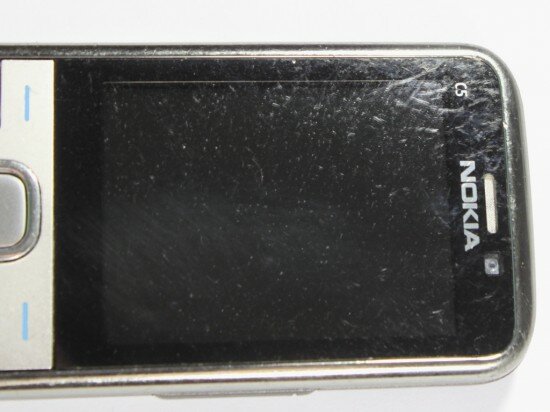
Pic. 15. Cracks on the screen
The grade is 10 (with 15 being the highest possible grade)
2.5 Scratch test
This time, we scratched the Nokia C5 at the force of 300 g (0.66 lbs). The deep scratch on the screen spoiled the picture quality greatly (video 9). The fresh scratch on the back panel was almost the same as the one made in the previous scratch test.
Video 9. Screen scratching (the force is 300 g (0.66 lbs))
The screen gets 10 points (with 15 being the highest possible grade)
The back cover gets 10 points (with 15 being the highest possible grade)
2.6 Freeze test
A lot of people have to use their cell phones in extreme weather conditions that are typical for the countries where they live. In this test, we checked the performance of the Nokia C5 in extremely cold weather.
We took a box filled with ice cubes, placed the handset in it, and then placed the box in a freezer. The phone was left in speaking mode during that time. The temperature in the freezer was approximately -15 – -20 °C (+5 – -4 °F).
Two hours later, we took the phone out (video 10). In general, the result wasn’t bad: the battery was absolutely full – the indicator displayed all the 6 bars. The display malfunctioned sometimes and it was hard to press the frozen keys. But we could live with that.
Video 10. Freeze test
The grade is 18 (with 18 being the highest possible grade)
2.7 High temperature
In this stage of the test, we increased the time of heating to 5 min. The result was the same as the previous time. Despite the keyboard was very hot, the gadget showed no damage.
The grade is 12 (with 12 being the highest possible grade)
2.8 Immersion in water
It’s time we dunked the Nokia C5 under water. We don’t even remember the time, when a cell phone failed this test.
We dunked the Nokia C5 under water for 1 sec. (video 11). The phone sustained no damage. Despite a bad build quality and the absence of protection of the connectivity ports, the battery and the microUSB port stayed almost dry. The handset sustained no damage and after the air drying it performed pretty fine.
Video 11. Immersion in water for 1 sec
The grade is 30 (with 30 being the highest possible grade)
2.9 Dust test
This time, we shook the enclosed tray containing the phone and dust for 5 minutes. We have never seen a cell phone with so much dust under the back cover (Pic. 16). It seemed that if there had been no back cover at all the result could have been better. Few grains of dust penetrated the connectivity ports (Pic. 17). The microUSB slot also stayed almost clean.
A lot of sand penetrated the keyboard again (Pic. 18). It was hard to press the keys on the rows of the numpad near the sides of the handset (1, 4, 7, 3, 6 and 9). Despite the keyboard was squaking all the time, all the keys stayed functional. We did not manage to clean all the sand. However, all the dust was shaken out of the keyboard during the test in the drum. Some grains of sand penetrated under the screen glass but they were visible only when the screen lighting was off (Pic. 19).
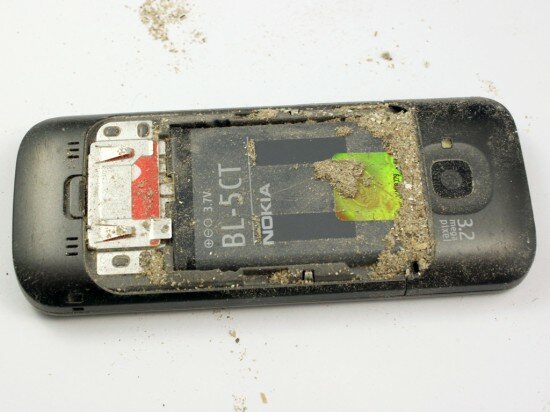
Pic. 16. Dust under the back cover
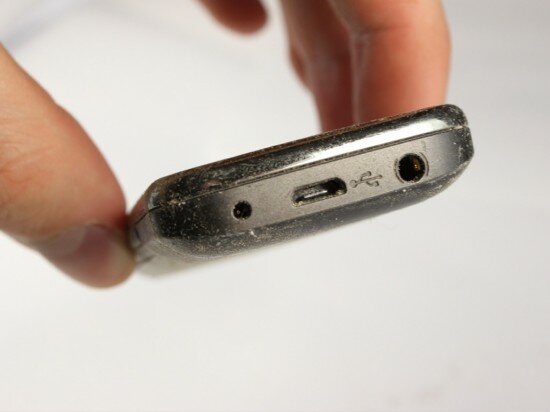
Pic. 17. Dust in the connectivity ports

Pic. 18. Grains of dust between the keys
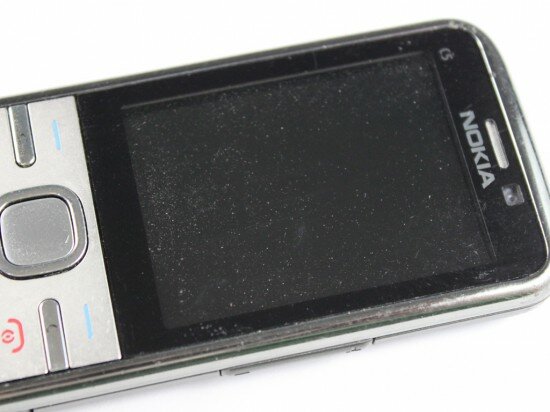
Pic. 19. Small grains of dust under the screen glass
The grade is 8 (with 12 being the highest possible grade)
2.10 Connectivity
We reduced the signal by making the size of the hole smaller: 20 x 20 mm (0,787 x 0,787 inches). Though the signal strength was reduced to 2 bars (with 6 being the maximum number of bars), the Nokia C5 received all the incoming calls with no problem (video 12).
Video 12. Connectivity test
The grade is 15 (with 15 being the highest possible grade)
After the 2nd stage of the stress test, the Nokia C5 got 226 (with 240 being the highest possible grade)
3. Nokia C5 stress test. Stage 3 — The toughest conditions
3.1 Drop test
At the last stage of the stress test, we dropped the Nokia C5 on the carpet (video 13) from 2 m (6.56 ft) and on the tile (video 14) from 1 m (3.28 ft). Drop on the tile simulates situations when cell phones fall out of jacket pockets on a hard floor.
During the test, the back cover was falling off all the time. The SIM Card was dislodged because of the bumps. After the drops on the tile, we saw a small dent and some new cracks on the front panel of the phone (Pic. 20).
Video 13. Drop on the carpet from 2 m (6.56 ft)
The grade is 30 (with 30 being the highest possible grade)
Video 14. Drop on the tile from 1 m (3.28 ft)
The grade is 20 (with 30 being the highest possible grade)
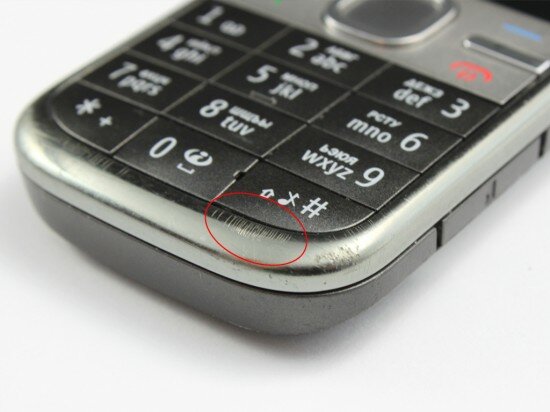
Pic. 20. Small dent and cracks on the steel edging
3.2 Squeeze test
At the last stage of this test, we increased the force of squeezing to 20 kg (44 lbs). The phone stayed safe. We heard the unpleasant noise produced by the grains of dust and sand stuck between the front and the back panels that bore against each other.
The grade is 24 (with 24 being the highest possible grade)
3.3 Bend test
We applied 10 kg (22 lbs) weight in our attempt to bend the Nokia C5 (video 15). The phone sustained a bend but stayed functional.
Video 15. Bend caused by 10 kg (22 lbs) weight
The grade is 24 (with 24 being the highest possible grade)
3.4 Durability
We increased the time of this test to 20 min. The result was predictable: the gunmetal effect edging was gone on the corners (Pic. 21). A lot of new scuffs on the corners of the top edge of the phone made the back panel look ugly (Pic. 22). Despite a great number of small scratches, the back cover still looked attractive. The deep scratches on the screen ruined the quality of the picture (Pic. 23). The only thing that showed no damage at all was the numeric keypad: neither scuffs, nor scratches (perhaps we simply didn’t notice them).
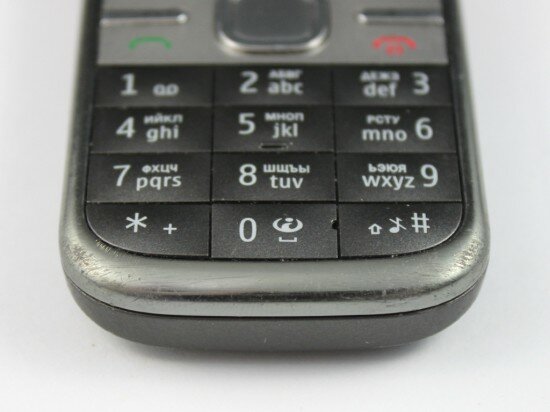
Pic. 21. The front panel after the test
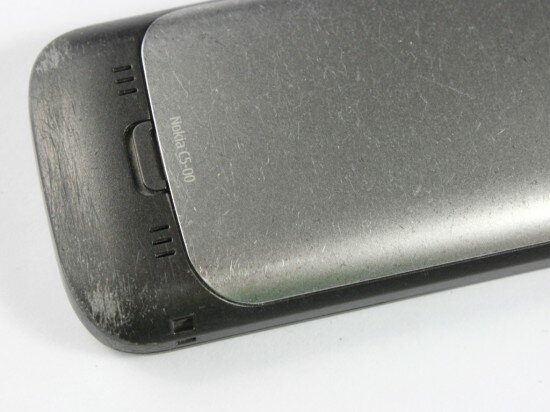
Pic. 22. The back panel after the test
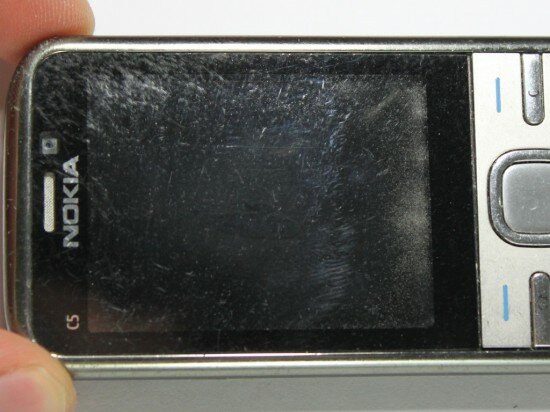
Pic. 23. Scuffs on the screen
The grade is 10 (with 15 being the highest possible grade)
3.5 Scratch test
At the 3rd stage of this test, the force of scratches was 600 g (1.322 lbs). The size of the scratch on the screen was twice compared to the previous test (Pic. 25, video 16). The scratch on the steel back cover was a bit deeper than before, but it was still almost invisible (pic. 24, video 17).
Video 16. Screen scratching
Video 17. Back cover scratching
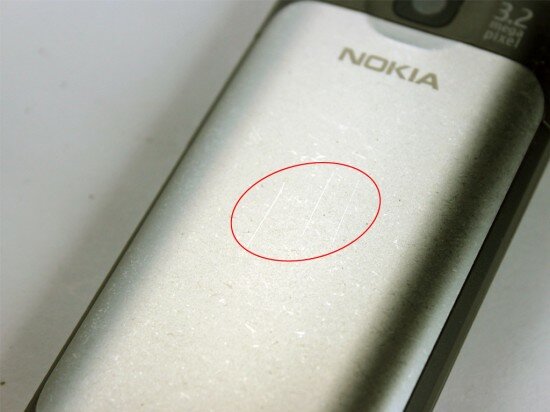
Pic. 24. Scratches on the back cover
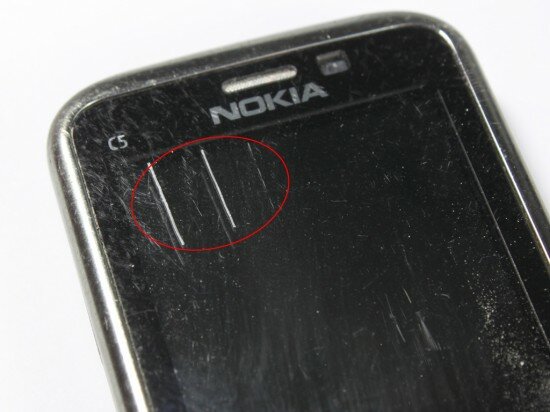
Pic. 25. Scratches on the screen
10 points for the screen (with 15 being the highest possible grade) for the screen
15 points for the back cover (with 15 being the highest possible grade) for the back cover
3.6 High temperature
We doubled the time of heating compared to the previous test. Surprisingly, the Nokia C5 stayed fine. The color rendering was as good as before the test. However, when we looked at the phone closer, we saw that the bulb had melted the screen. Anyway, the Nokia C5 showed a good result in this test.
The grade is 12 (with 12 being the highest possible grade)
3.7 Immersion in water
In this test, we increased the time of immersion to 20 sec. (video 18). The phone stayed absolutely functional. Moreover, when we made a call after the test, the volume of the ring and the call quality of the phone were perfect. The loudspeaker and the polyphonic speaker stayed showed no damage.
Water penetrated the circuit board of the phone through the back cover. The connectivity ports on the top edge were filled with water. Despite all this damage, the Nokia C5 performed pretty fine. After air drying, we saw a steam condensate under the screen. We left the handset under the blow of warm air for an hour. The gadget became absolutely dry and worked well afterwards.
Video 18. Immersion in water for 20 seconds
The grade is 30 (with 30 being the highest possible grade)
3.8 Immersion in beer
In Technocrash lab, any cell phone can get a glass of beer. We dunk in beer all the gadgets that come to our hands. The Nokia C5 wasn’t an exception.
Actually we immersed the phone in beer for 10 sec. (video 19). The result was unpredictable. All the connectivity ports of the handset are exposed, and we saw the spots of beer in the microUSB port after the test (Pic. 26). But the Nokia C5 didn’t give a warning that the headphones were plugged in. This is a fail of the majority of the gadgets that pass this test.
The keyboard stayed functional. In a minute after the test, the SIM card connection failed.
After washing and air drying, we rebooted the phone and saw spots of beer on the display. They spoiled the picture, especially when the picture was bright (Pic. 27). The phone performed with no problem, though.
N.B. The spots of beer disappeared only in a day.
Video 19. Immersion in beer for 10 sec
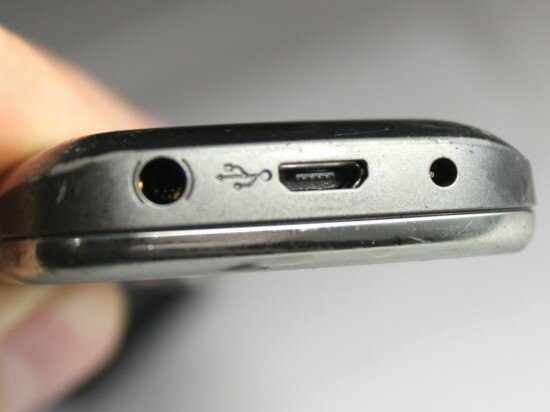
Pic. 26. Spots of beer in the microUSB port
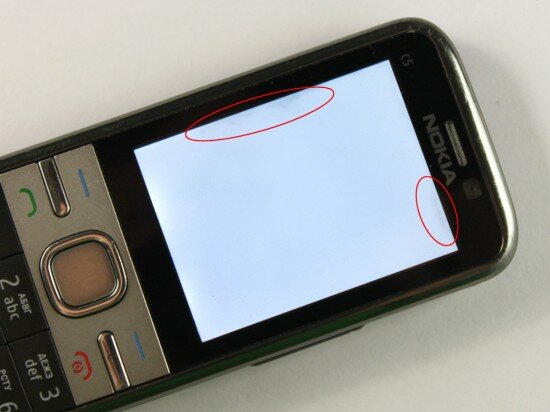
Pic. 27. Spots of beer on the display
The grade is 6 (with 9 being the highest possible grade)
3.9 Dust test
This time, the result was worse than in the previous dust tests. Grains of dust penetrated the loudspeaker membrane and spoiled the call quality. The polyphonic speaker stayed functional. The connectivity ports were filled with sand (Pic. 28). We saw a lot of dust in the microUSB slot (Pic. 29) and under the screen (Pic. 30). The quality of the picture was ruined. The keyboard showed the same result as in the previous tests.
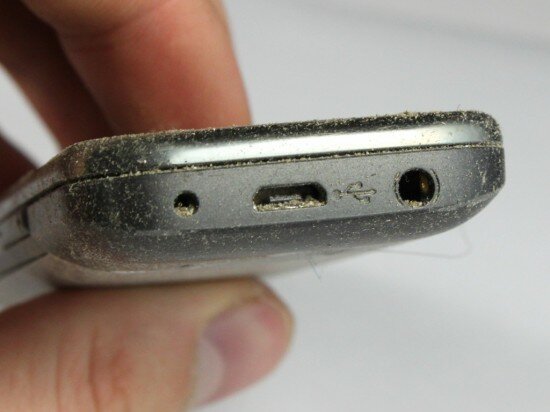
Pic. 28. Dust in the connectivity ports
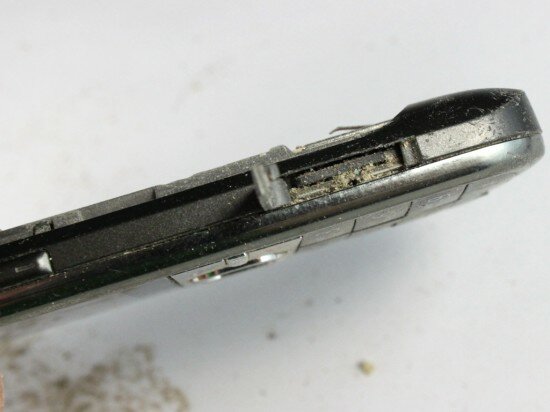
Pic. 29. Dust under the cover of the memory card slot
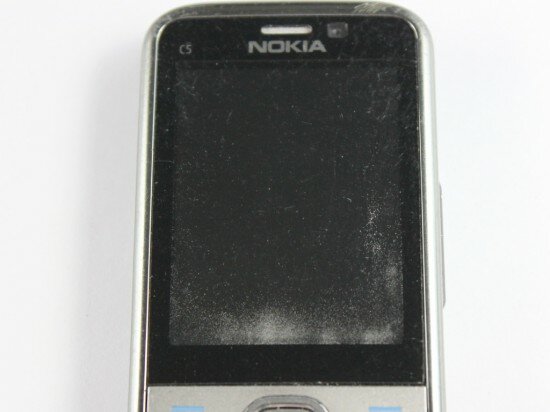
Pic. 30. Dust under the screen
The grade is 10 (with 15 being the highest possible grade)
3.10 The keypad
On the one hand, the keypad is ruggedized because it withstood heat, frost and liquids and stayed functional during all the tests. It sustained neither scuffs, nor scratches while the other parts of the phone suffered a lot.
On the other hand, the large seams between the keys let all the dust in the phone. This is the reason why the keyboard squeaked. A pretty thin frame of direction keys is raised above the numeric keypad and can be easily scratched when the phone is in a pocket.
The grade is 10 (with 15 being the highest possible grade)
3.11 Connectivity
At the last stage of the test, we decreased the size of the hole to 15 x 15 mm (0,59 x 0,59 inches). The signal strength of the Nokia C5 wasn’t perfect. The phone received all 10 incoming calls. However, three calls were cut off. The signal indicator displayed 1-2 bars.
Video 20. Connectivity test
The grade is 15 (with 15 being the highest possible grade)
3.12 Short circuit and overcharge
In order to test the battery charger, we made a 1 second short circuit of the the “+” and “-” with the help of the forceps (video 21). The battery charger stayed fine and charged the battery with no problem.
Video 21. Short circuit of the battery charger
The grade is 15 (with 15 being the highest possible grade)
We prepared the same test for the Nokia C5’s battery: 1 second short circuit of the “+” and “-” (video 22). The battery stayed safe and full.
Video 22. Short circuit of the battery
The grade is 15 (with 15 being the highest possible grade)
Sometimes, people use the battery chargers produced for other cell phone models rather than for the model that they have. In this test, we simulated the situation when cell phones are powered by non-original battery chargers that may have different charging power.
We plugged the battery charger in the PSU and the PSU cable in the Nokia C5 (video 23). At first, we decreased the power – the charging was stopped at 3.7 V. It resumed when we increased the power till 4.6 V – quite a good result.
Next, we checked the ability of the phone to protect itself from overcharge. The target point was 8 V. We increased the charging voltage – the charging was stopped at 7.4 V. During this test, the energy consumption was normal. This is a good result.
Video 23. Increase/decrease in charging voltage
The grade is 15 (with 15 being the highest possible grade)
Finally, we examined the phone’s energy consumption. We took the battery out and plugged the PSU in the phone. The reaction of the gadget was strange. The phone gave a warning that the battery was empty. Actually, the battery was full. That is why we did not pay much attention to this warning and went on.
At first, we increased energy supply till 7 V (video 24). The Nokia C5 stayed functional. The power consumption was normal. In this test, the phone showed excellent results.
When we decreased energy supply, the phone switched to the energy economy mode and then switched itself off. It was problematic to switch the Nokia to the normal mode. We placed the battery in the slot but the display illumination was still dull. We had to charge the battery in order to solve this problem (video 25).
Video 24. Power supply increase
Video 25. Switching the phone to the normal mode
The grade is 10 (with 15 being the highest possible grade)
3.13 Disassembling
According to our tradition, we disassembled the Nokia C5 and examined its internal design (Pic. 31). We saw some spots of beer or water under the display. However, all the important components of the phone stayed safe. The internal design of the Nokia C5 is typical for the handsets produced by the Finnish manufacturer. It resembles, for example, the design of the Nokia N71. The circuit board is large. It occupies almost all the space inside the casing. However, the circuit board contains few components that are placed mostly on the front side. The shields that protect the circuit board are non-removable.
We also found out that the screen glass is not made of plastic. It turned out to be a flexible thick film.

Pic. 31. The Nokia C5 disassembled
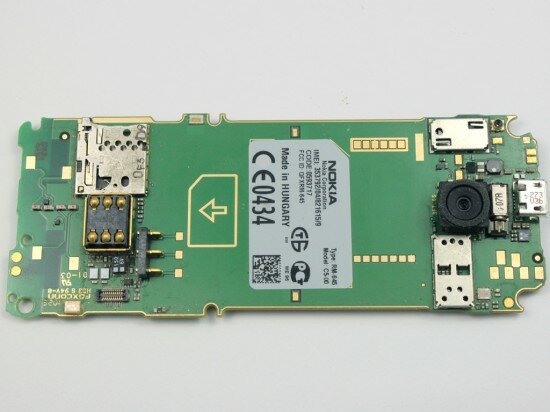
Pic. 32. The circuit board of the Nokia C5 (the back side)

Pic. 33. The circuit board of the Nokia C5 (the front side)
The grade is 10 (with 15 being the highest possible grade)
After the 3rd stage of the stress test, the Nokia C5 got 294 points (with 351 being the highest possible grade)
The Nokia C5, an economy class smartphone, showed the results that we expected to see. By the way, it didn’t fail any test. This gadget is a good value for money. However, the handset couldn’t stand up successfully to the drops and bumps and it’s not dust resistant at all. Scuffs and scratches are likely to appear after a few months of use. But what else would you expect from the phone (pardon, smartphone) that costs so little?
The Nokia C5 survives extremely high and low temperatures with no problem. The battery showed excellent results in all the tests. The gadget sustained no damage after the immersions in water and in beer. But we don’t recommend you to do this at home.
Here’s how the gadget looks like after all the tests (Pic. 34, 35, video 26).
Video 26. Here’s how the gadget looks like after all the tests
Video 27. Here’s how the gadget looks like after all the tests (macro)
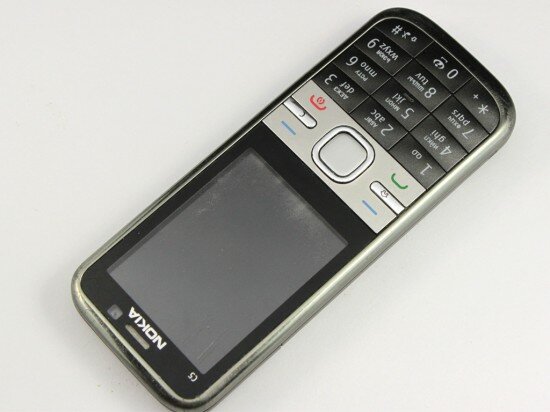
Pic. 34. The front panel of the phone after the test
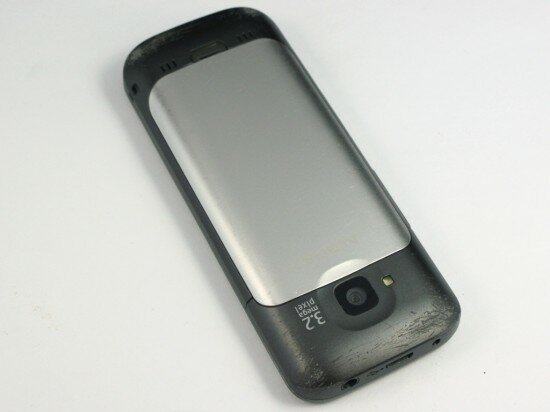
Pic. 35. The back panel of the phone after the test

 Russian version
Russian version
Comments (3)
Nokia c5 almost passed all the stress test. it also passed the stress test applied on it by me daughter , she likes to throw it whenever she sees it in my hand , and fortunately it is still working ……
Great stress tests!
I’m going to buy this phone
i own a Nokia C5-00 and its giving me problems ever since it fell in water,I air dried it. it worked fine for a few days then it just never worked like it used to, it gives me a message say its gonna restart and it automatically goes into offline mode
Trackback/Pingback (1)
[...] Water and dust resistance of mobile gadgets shouldn’t be underestimated. Small grains of dust may inflict real damage. We witnessed how dirt broke the keys of the phones for several times, e.g. the Nokia C5. [...]